2014 Ktm 300 Exc Horsepower
Click on images to enlarge
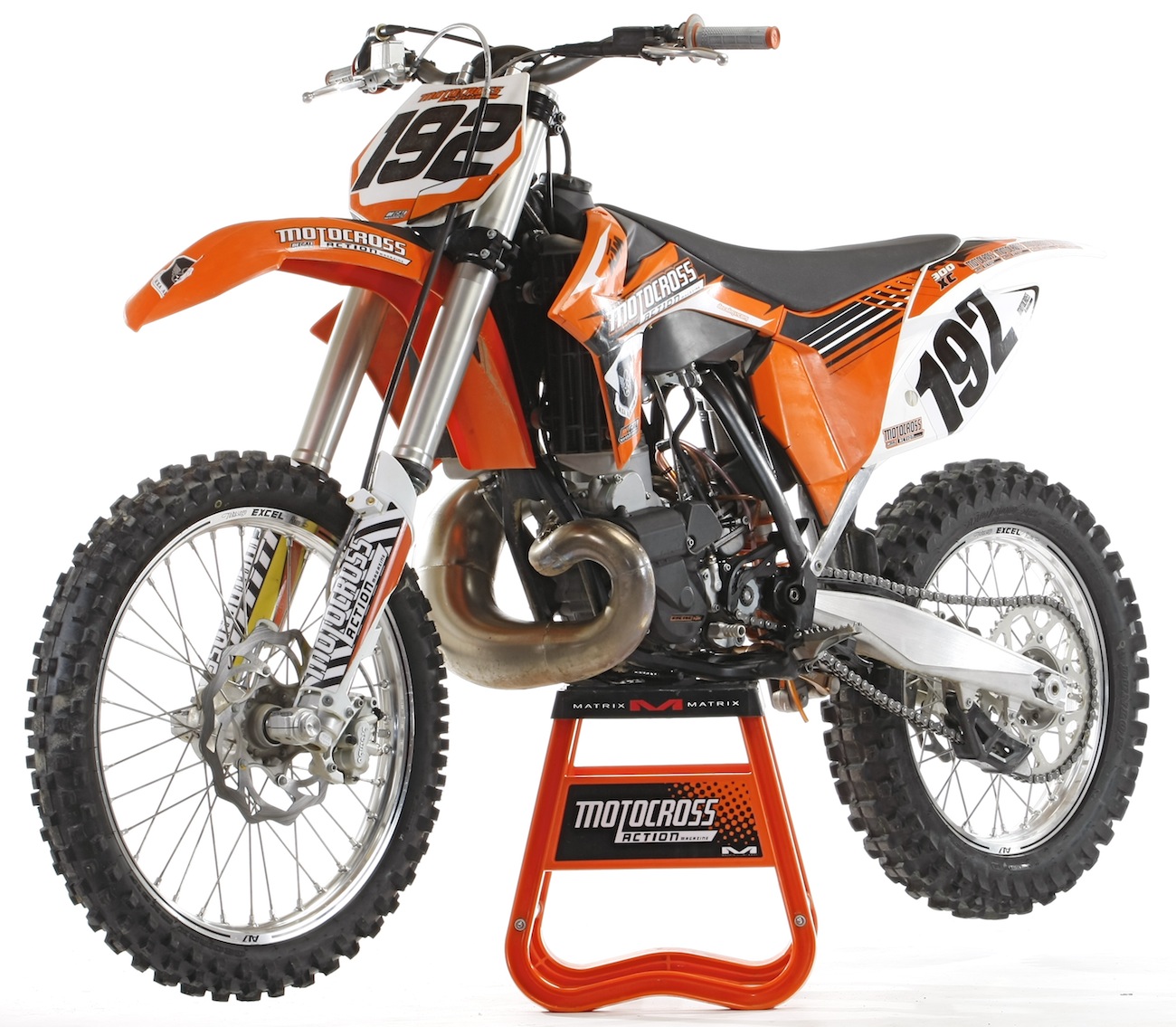 You don't often see MXA doing stroies on older models, but there are lots of previously used KTM 300XCs out there that still have life in them — like MXA's 2012 model.
You don't often see MXA doing stroies on older models, but there are lots of previously used KTM 300XCs out there that still have life in them — like MXA's 2012 model.
By Jody Weisel
The vast majority of my racing life has been spent on two-strokes, but I'm a realist. When the four-stroke revolution came along, I didn't feel a need to fight it. I have said many times that, if I weren't a motorcycle test rider, I would be racing a Yamaha YZ250 two-stroke. However, my lot in life is to race and test what's put before me, and, increasingly, since the four-stroke revolution began in 1998 and went full complement in 2006, the bikes I am assigned to race are four-strokes.
I'm not whining, nor am I anti-four-stroke; I just believe that the sport would be better off with cheaper-to-purchase, less-expensive-to-maintain, simpler-to-work-on, 20-pound-lighter and more-powerful-per-cubic-cc two-strokes than bulkier, heavier, costlier and more complicated four-strokes. As technically advanced as a modern four-stroke engine is, it's still Ford Model A-era when compared to a light and powerful two-stroke. A smoker's power-to-weight ratio is unbeatable—except by those geniuses at the AMA. You may not believe me, but I'm past worrying about what the masses think.
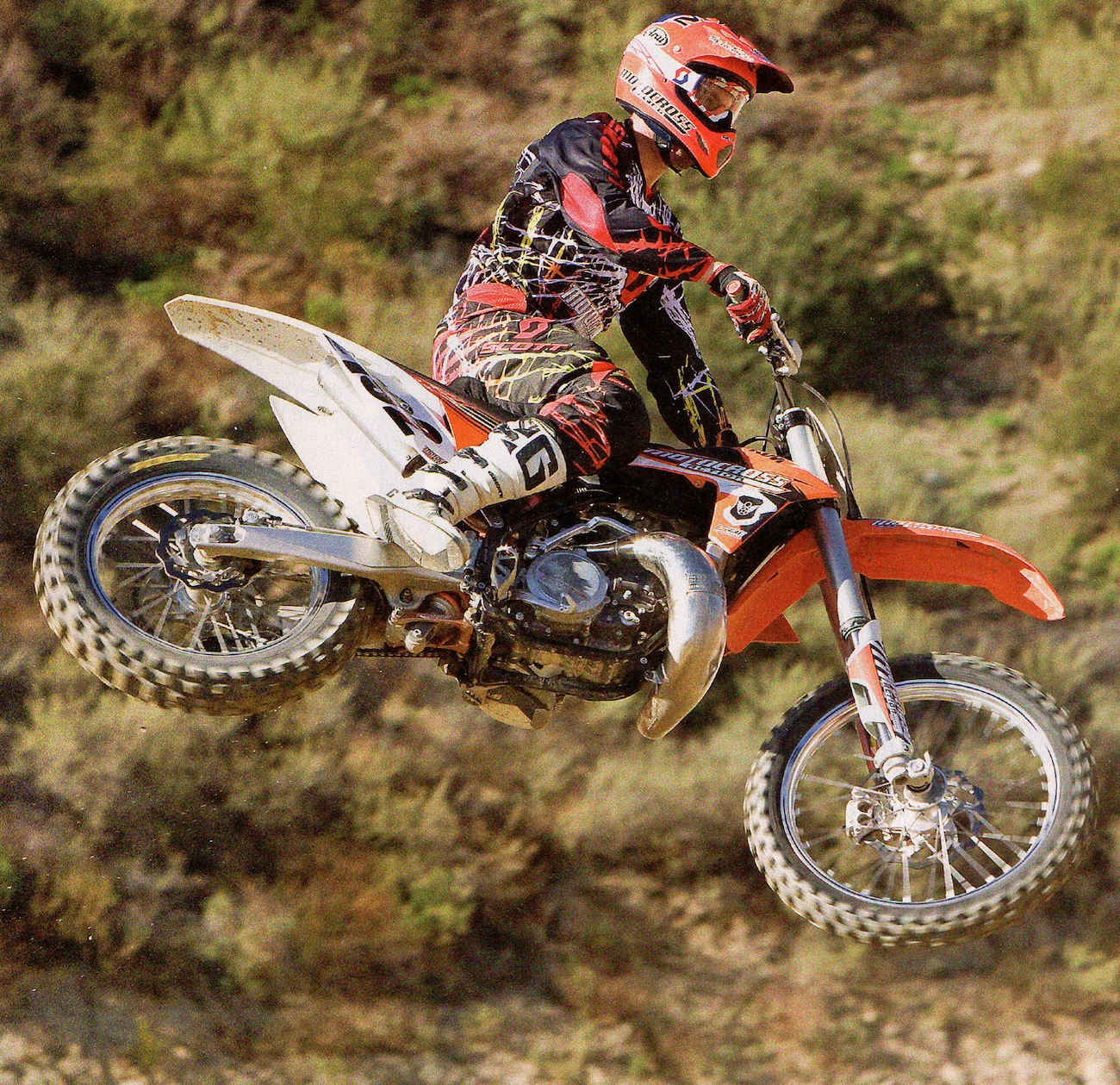
Thus, several years ago when I was assigned to run MXA's test program on the KTM 300XC cross-country bike, I considered myself lucky. (Actually, I make the test assignments at MXA, so luck really had nothing to do with it). I wanted to test the 300XC because I wanted to race it. I felt that a torquey 300cc two-stroke would be the perfect mix of power and thrust to race with 450 four-strokes. I wasn't worried about beating them, because I wasn't beating them on a 450 thumper. But I had to complete the test assignment to find out. This isn't a new bike and it doesn't have the bells and whistles of the latest version of the KTM line, but it is a popular 300XC and it was where MXA wanted to start.
The regimen for testing is fairly straightforward. First, the studio photography is shot, followed by the action photos, and then the dyno time. Only then do we start a series of test days with different riders to try to discover every nuance of the bike. As the test riders work their way through each phase, the project leader collates the input, makes the suggested changes and arranges to retest every alteration. Finally, we begin racing the bike to ensure that our setup and test data aren't pie in the sky. It is quite an exhaustive procedure, but fun at the same time.
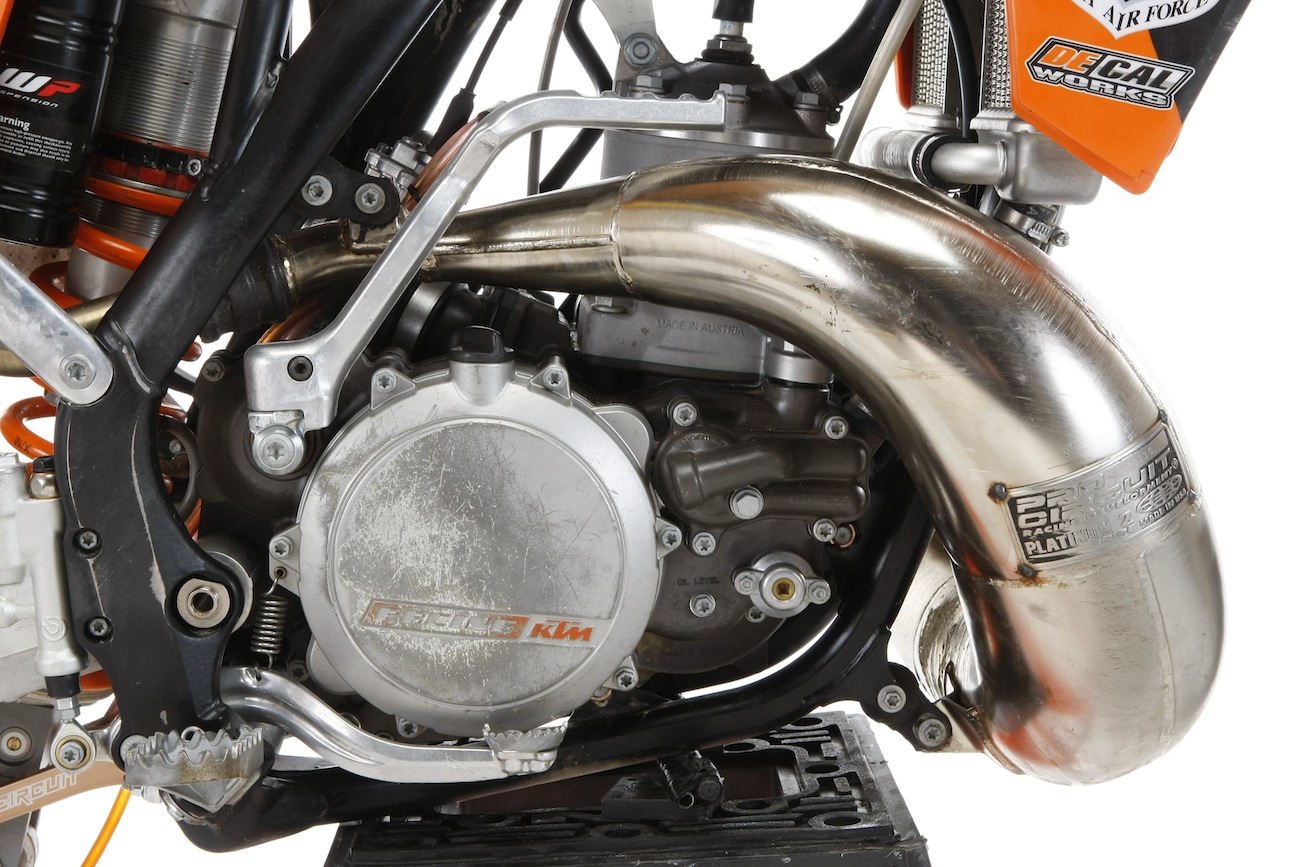 We ran a Pro Circuit Platinum 300XC pipe. It boosted the power significantly.
We ran a Pro Circuit Platinum 300XC pipe. It boosted the power significantly.
When it came time to start racing the KTM 300XC, we always had two different skill-level testers race the bike on the same day. They would race the bike in their respective classes and make adjustments to suit their needs.
I FULLY UNDERSTAND THAT THE KTM 300XC IS WIDELY BILLED AS A "JACK OF ALL TRADES," BUT APPARENTLY "ALL" DOES NOT ENCOMPASS MOTOCROSS
After my first motocross race on the stock KTM 300XC, I determined that it couldn't be raced with any success in motocross as it sat. That belief was confirmed as riders as lowly as I and as mighty as the AMA National Pros did their time on the bike. It was too soft, geared too tall, too mellow and too strangely configured for the specific demands of motocross. I fully understand that the 300XC is widely billed as a "jack of all trades," but apparently "all" does not encompass motocross.
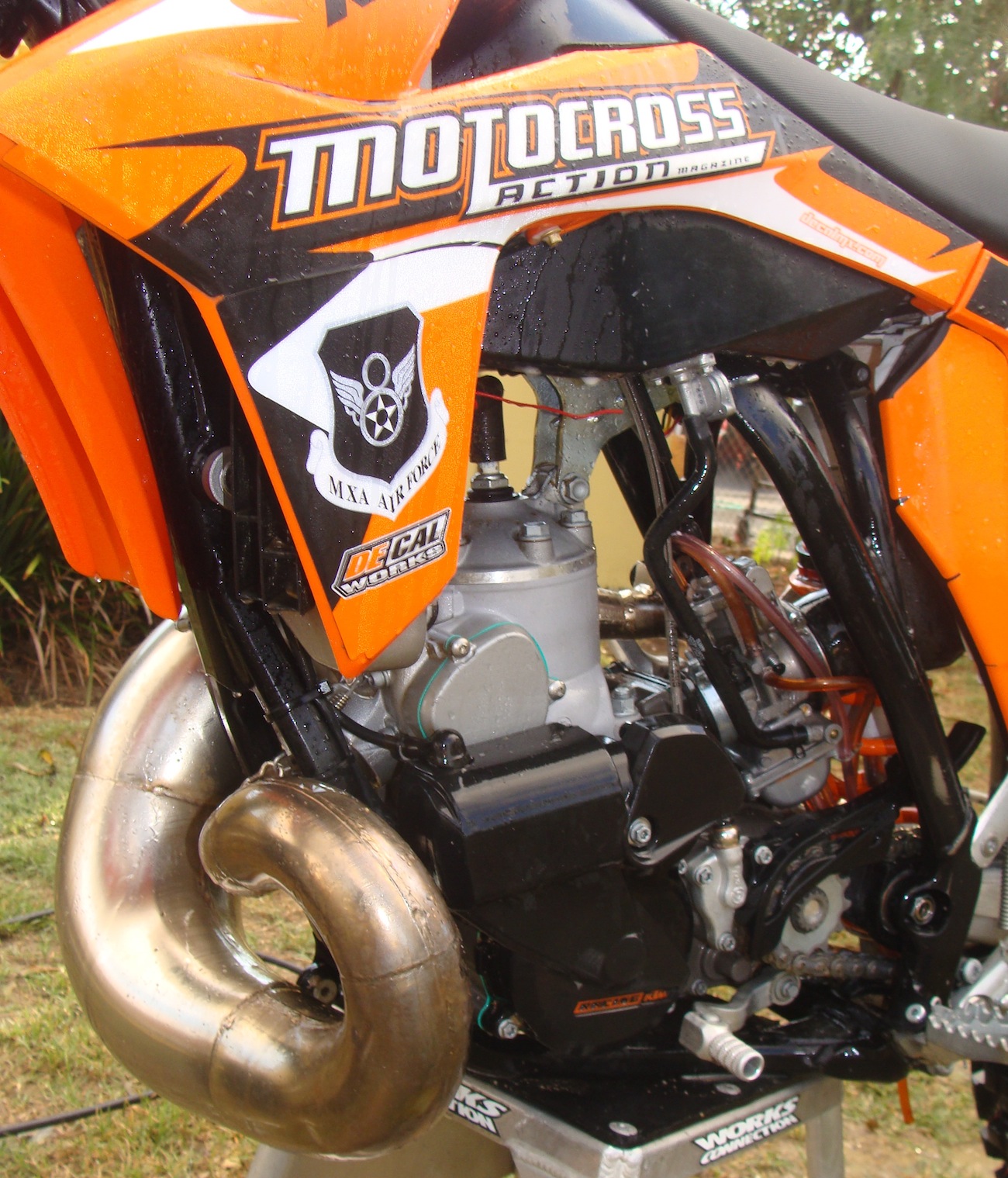
I was left to work the kinks outr as the rest of the MXA test crew members had lots of new bikes on their to-do lists. With time on my hands, I decided to build a full-race KTM 300SX out of our stock 2012 KTM 300XC. Since money is never an issue at MXA, I had carte blanche to do whatever I wanted to the bike to make it meet the high expectations that I had for it two months earlier when I falsely believed that it would be the answer to the two-stroke racer's prayers. These are the steps I took to build a moto-ready 300cc two-stroke motocross bike.
STEP ONE: I MADE A BIG MISTAKE FROM THE GET-GO THAT WAS OBVIOUS TO EVERYONE BUT ME, BUT BEFORE I REVEAL MY BLUNDER, LET ME INCLUDE ONE DISCLAIMER
I made a big mistake from the get-go that was obvious to everyone but me. But before I reveal my blunder, let me include one disclaimer: I don't race enduros, cross-country, GNCC, WORCS, woods, hare scrambles, desert or anything that gets out of sight of an ambulance, or isn't lined with ribbon. I'm a motocrosser—and that's all I am. (Even when I was an AMA road racer, I tended to use motocross lines.) This clarification is important, because it means that all the offroad charms of the KTM 300XC were lost on me. I have no intention of racing a WORCS race this weekend and the World Two-Stroke Motocross Championship next weekend. (As a side note, even though I live in SoCal, I have never surfed in the morning and skied in the afternoon—and I don't know anybody who has.) I only care about motocross.

My major mistake was that I didn't need to start with a KTM 300XC. I could have saved a bundle of money if I had used a KTM 250SX and put KTM's Power Parts 300cc cylinder kit on it. I could even have gotten the Power Parts 300 kit with XC porting. Given that all of MXA's KTM 250SXs arefully set up to go, it would have made more sense. For around $950, I could have had the thing up and running as a 300SX in about two hours. Given the $7250 price tag of the 250SX and the $950 needed for the big-bore kit, I'd have been in and out of this project for around $8200.

But, I didn't do that. I began with an $8550 KTM 300XC and started throwing money at it like the Pope sprinkles holy water on Easter Sunday. The increased retail price of the 300XC versus the 250SX is because the XC comes with the 300cc engine kit, six-speed transmission, larger gas tank, 18-inch rear wheel, kickstand, hand guards, heavier flywheel and electric starter. All nice touches, but, in truth, I only wanted the big-bore engine.
STEP TWO: NONE OF THE MXA TEST RIDERS COULD RACE THE STOCK 300XC TO ITS FULLEST POTENTIAL BECAUSE OF THE ENDURO/CROSS-COUNTRY SUSPENSION SETTINGS
None of the MXA test riders could race the stock 300XC to its fullest potential on a motocross track because of the enduro/cross-country suspension settings. It was so soft that on Glen Helen's massive Mount Saint Helen downhill, the forks would bottom out when you applied the brakes…and then the rear end would kick. Test riders had to slow down to stay in the window of the forks and shock.
Fork fix:
In stock trim, the enduro soft 0.44 kg/mm fork springs on the 2012 model allowed the front suspension to dive too much, eating up usable travel before it even encountered a bump. We drop-kicked the 0.44 kg/mm fork springs for 0.48 kg/mm springs (and supplemented with vigorous clicking of the compression and rebound settings). In the end, we revalved the XC forks to SX damping specs.
Shock fix:
The shock was way too soft. We couldn't get 100mm of race sag before the stupid nylon preload ring would seize on the shock threads. In the end, we were forced to replace the stock 5.4 kg/mm spring with the 5.7 spring (and eventually revalved the shock to suit our needs).
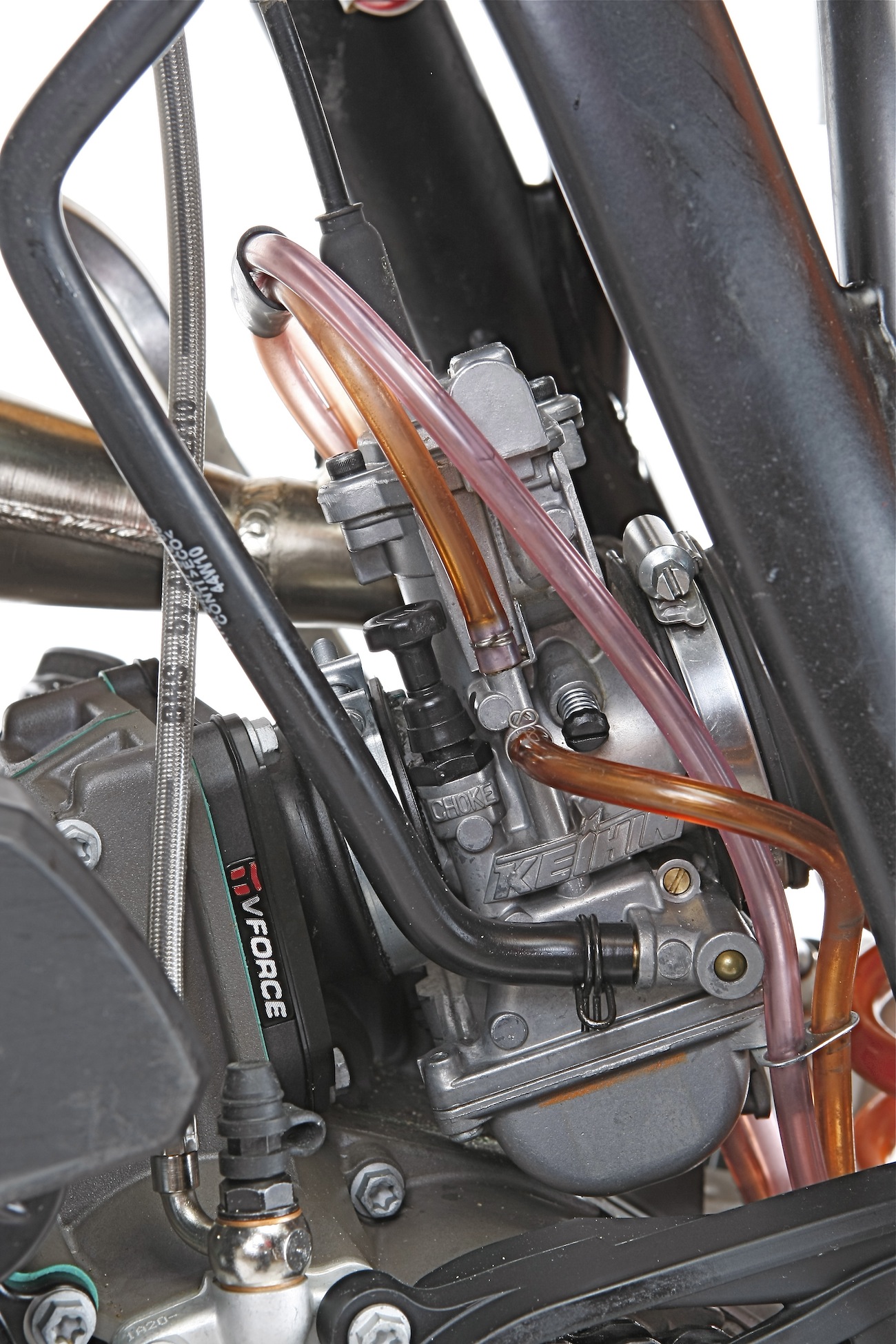 We didn't have any major jetting issues, but it isn't something you can ignore. We had to keep up on jetting changes with temperature changes.
We didn't have any major jetting issues, but it isn't something you can ignore. We had to keep up on jetting changes with temperature changes.
STEP THREE: POWER IS NOT A PROBLEM ON THE 300XC, BUT IT CAN BECOME ONE IF YOU TURN THE XC INTO AN SX
Power is not a problem on the 300XC, but it can become one if you turn the XC into an SX. Our time on the dyno revealed that the KTM 300XC made a healthy 51.02 horsepower, which was one horsepower more at peak than the 250SX (it was strange to find that the 2012 models made more peak horsepower than the new 2017 models). Apart from the section of the rpm curve where the 250SX hits like a country mule (from 7500 rpm to 8000 rpm), the 300XC makes two to three more horsepower above and below the 250SX's sweet spot. It doesn't feel faster than the 250SX because it doesn't have the aggressive hit, but it is considerably more powerful across the board. The power delivery is night-and-day different from the 250SX's. The stock 300XC's power delivery is old-lady mellow.
In search of more power, we mounted a Pro Circuit KTM 300XC exhaust system on the bike. (We were surprised that they made a pipe specifically for the 300XC.) It was awesome. The aftermarket pipe wiped out the 250SX's advantage from 7500 rpm to 8000 rpm and in the process added 3-1/4 horses at 7000 rpm, two horses at 8000 rpm, 1-7/8 horsepower at 9000 rpm and almost six horsepower at 9500 rpm. (The 300XC signs off before 10 grand.) That doesn't mean that the pipe increased the peak horsepower from 51.02 to 57.02 horsepower, only that it filled in extra horsepower where it would do the most good. The biggest plus was that the power didn't become peaky or spikey.
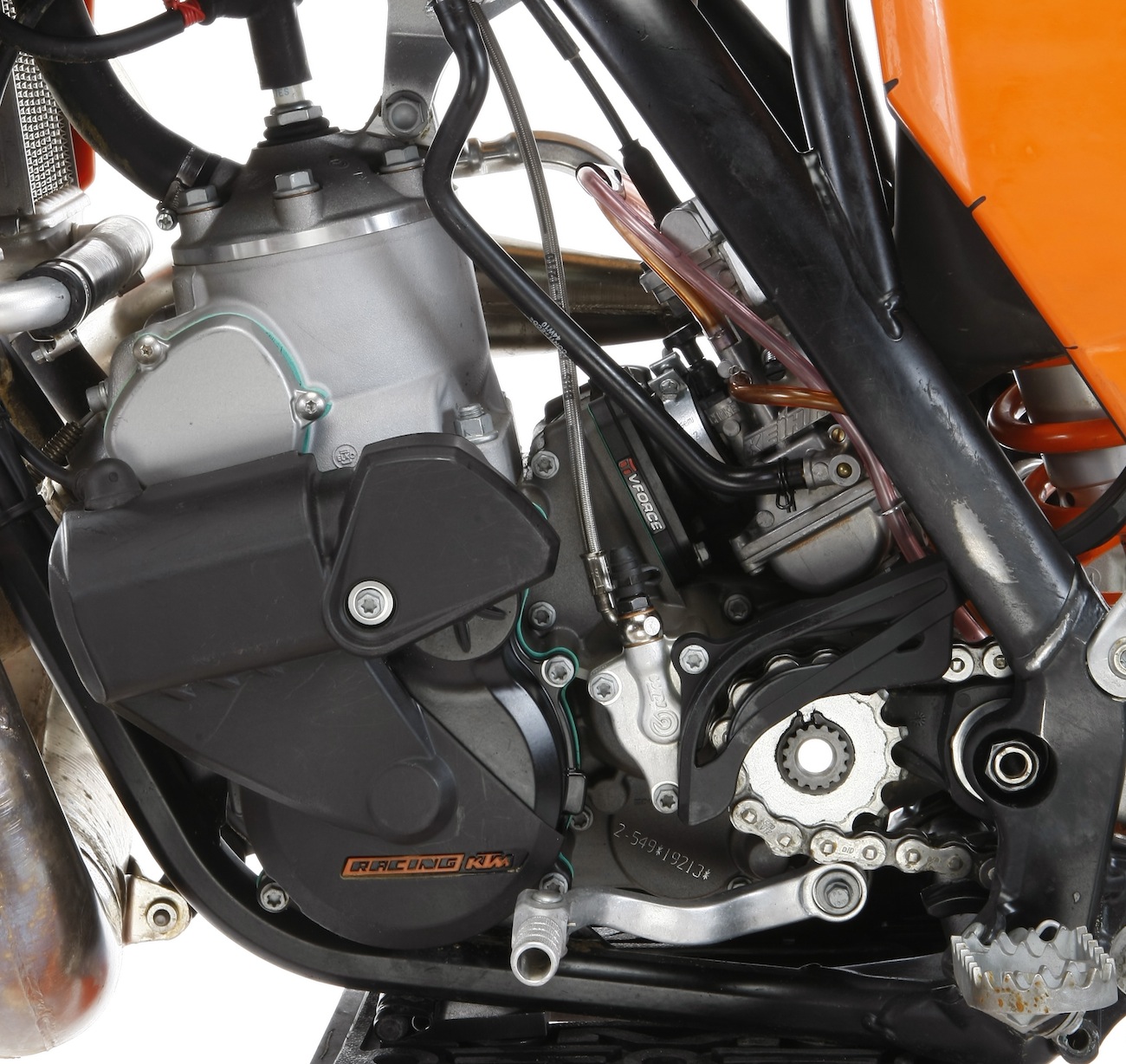 The electric starter was a novelty item, but pretty soon every test riders decided that they liked it. It adds to the cost of the 300XC versus the 250SX.
The electric starter was a novelty item, but pretty soon every test riders decided that they liked it. It adds to the cost of the 300XC versus the 250SX.
STEP FOUR: AS YOU WOULD EXPECT, THE SIX-SPEED 300XC GEARBOX DID NOT SHARE ANY GEAR RATIOS WITH THE FIVE-SPEED 250SX GEARBOX
As you would expect, the six-speed 300XC gearbox did not share any gear ratios with the five-speed SX gearbox. (Although the primary gear was the same, the final drive on the 300XC was 14/50, while the 250SX used a 13/48.) Or at least we thought so. We initially thought that the gear ratios on the six-speed would be too low. Wrong! First gear was lower and sixth gear was Abu Dhabi-skyscraper tall. We have to take KTM's word for it that the bike even has a sixth gear, because we never got near it. Selecting the proper gears became a full-time occupation. We changed it many times in search of the best motocross setup.
Our strategy was to ignore first and sixth gears completely and focus on getting a final drive ratio on the 300XC that was as close as possible to the 250SX ratio, which we liked. With enough math and pencil sharpeners, we discovered that a 14/51 gave us a 3.643 gear ratio, while a 14/52 would put us at a slightly lower 3.714 ratio. The 250SX has a 3.692 gear ratio (right between our two possible 300XC combinations). We chose the slightly lower 3.714 gearing on the 300XC to help us get to third gear sooner and ran the 14/52. Then, we found other stock 300XC's that had 13-tooth countershaft sprockets. The specs said they all came with 14s, but many had 13s. We installed a 13-tooth countershaft sprocket and checked the gearing again…and ended up with a 13/49.
STEP FIVE: THERE IS GEARING IN THE SIX-SPEED GEARBOX THAT WILL WORK FOR EVERY RIDER, TRACK AND SITUATION, BUT YOU HAVE TO FIND IT. AND, WE NEVER GOT ALL SIX GEAS TO WORK—WE HAD TO CHOOSE WHICH GEARS WE WANTED.
There is gearing in the six-speed gearbox that will work for every rider, track and situation, but you have to find it. and, we never got all six gears to work—we had to choose which gears we wanted. Gearing was always an issue because the six-speed cross-country gearbox isn't as focused as the SX's five-speed. The five-speed SX tranny will fit in the six-speed 300XC cases, but it would be expensive and ruin the Jack-of-all-trades usability of the 300XC. Plus, there is gearing in the six-speed that will work for every rider, track and situation, but you have to find it yourself. Don't let the numbers confuse you. We couldn't perfectly match the final drive of the 250SX, so we based our gearing selections riding style and track layout. We gave up some gears because they were too low, only to find out that fourth gear was now too tall. We changed gearing so often that we wore the sprocket bolts out. But, by gearing for every track we went to, we had compromise gearing that worke don tight track and different gearing for fast tracks.
 We started with a stock 2012 KTM 300XC. It rolled off the assembly line with the big gas tank, kickstand, hand guards, longer silencer and stock springs.
We started with a stock 2012 KTM 300XC. It rolled off the assembly line with the big gas tank, kickstand, hand guards, longer silencer and stock springs.
STEP SIX: WE COULD HAVE EASILY LIVED WITH THE STOCK, TRANSLUCENT, 2.6-GALLON KTM OFFROAD GAS TANK, BUT WE DIDN'T WANT TO
We could have easily lived with the stock, translucent, 2.6-gallon, KTM offroad gas tank, but we didn't want to. The smaller 1.98-gallon motocross gas tank was considerably lighter (especially when full) and was easy to come by. KTM two-stroke owners can use either KTM two-stroke or 450 four-stroke gas tanks. We installed a 450SXF gas tank—in black.

STEP SEVEN: THE 300XC COMES WITH A BIG MEAT OUT BACK, AND CASUAL ONLOOKERS WERE ALWAYS SURPRISED THAT WE WERE STILL RUNNING THE 18-INCH REAR WHEEL
The 300XC comes with a big meat out back, and casual onlookers were always surprised to discover that we were still running the 18-inch rear wheel on our 300XC. They wondered why we hadn't swapped it out for a 19-incher. The answer is simple: For most outdoor motocross use, the 18-inch wheel works better than the 19. "Blasphemy," you say? Think about it for a second. It has more volume, a bigger footprint, a more forgiving ride in the rough and comes with the bike. If we were planning to race Supercross, perhaps switching to a low-profile, 19-inch wheel would make sense—but we're not, so we didn't. In the end, the wider tire choice available in 19-inchers might drive us towards a 19-inch rear wheel, but we don't feel compelled.
STEP EIGHT: WE DON'T CHANGE THE LINKAGE ON EVERY BIKE WE RACE, BUT IT SURE SEEMS LIKE IT SOMETIMES
We don't change the linkage on every bike we race, but it sure seems like it sometimes. One obvious advantage of the linkage KTM design over the no-link PDS bike is that both the suspension and handling can be altered with longer or shorter links. MXA prefers to run a 143.75mm shock linkage instead of the 2012's stock 142.50mm link. The extra 1.25mm not only lowers the rear of the bike, it stiffens the initial part of the suspension stroke to hold the suspension up higher in its stroke for a more aggressive feel. Even tested with a longer 144mm link, but it isn't for sale to the public. The longer link stiffens the initial part of the rear stroke to hold the rear end higher in the bumps…and lowers the rear of the bike to make the bike flatter and more balanced.
 The longer Pro Circuit linkage, lowered the rear of the XC and helped make it stiffen in the initial part of the stroke.
The longer Pro Circuit linkage, lowered the rear of the XC and helped make it stiffen in the initial part of the stroke.
STEP NINE: IT SEEMS KIND OF SILLY TO HAVE AN ELECTRIC STARTER ON A 300cc MOTOCROSS BIKE, ALTHOUGH WE CAN SEE HOW IT WOULD COME IN HANDY IN THE WOODS
It seems kind of silly to have an electric starter on a 300cc two-stroke motocross bike, although we can see how it would come in handy in the tight confines of the woods. Once you get used to having the magic button, it becomes second nature to use it (and you eventually come to terms with the extra weight of the battery, starter motor and extra gear). Our only quibble was that on cold mornings (and some warm ones), the electric starter wouldn't start the bike the first time. Once the bike was warm, the E-button worked perfectly. Our final morning solution, which might seem strange, was to use a combination of the electric starter and the kick starter at the same time. This unusual approach worked amazingly well.
The extra weight is an issue. The 300XC weighs 231 pounds compared to the 217-pound weight of our 2012 250SX (and the 211 pound sof the 2017 250SX). We trimmed some of the weight off by changing gas tank and removing the side stand, but as long as we kept the electric starter, battery and heavier flywheel we were always going to be heavier than the 250SX. You might think that since the 300XC weighs close to what a four-strokes weighs that it would feel heavy–but remember that there is less rotating mass in a two-stroke top-end…and that makes the 300XC feel light in pitch, roll and yaw when compared to a thumper.
 The only visible clue that MXA's project bike started life as a 2012 300XC cross-country bike is the 18-inch rear wheel, which we initially kept because it worked very well.
The only visible clue that MXA's project bike started life as a 2012 300XC cross-country bike is the 18-inch rear wheel, which we initially kept because it worked very well.
STEP TEN: THE ONE THING WE DIDN'T WANT WAS LOTS OF POWER MATED TO A BRUTAL HIT AND AN ARM-JERKING RUSH
The one thing we didn't want was lots of power mated to a brutal hit and an arm-jerking rush. We have built KTM 250SXs with 300cc engine kits in the past, and they always produced incredibly powerful race bikes that verged on being schizophrenic. By using the production-based 300XC engine, we got the milder porting, heavier flywheel and torquey feel that make for an easy-to-ride two-stroke that is still fast. MXA's 300cc blending of XC and SX technology produced an awesome race bike.
As for my earlier confession that I had done this project a disservice from the get-go, I don't feel that way when I'm out on the track. But if I had to do it all over again, I'd skip the 300XC and start with a 250SX and the 300cc kit.


Source: https://motocrossactionmag.com/inside-secrets-of-building-a-moto-ready-ktm-300xc-two-stroke-racer-2/

0 Komentar